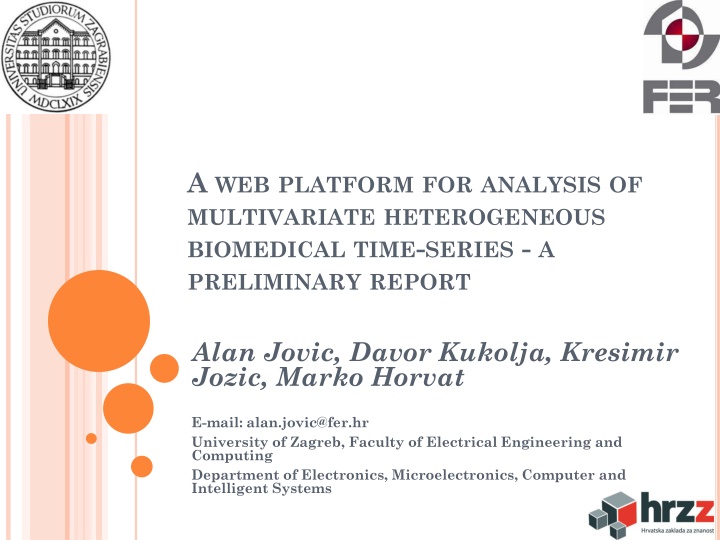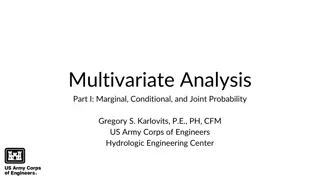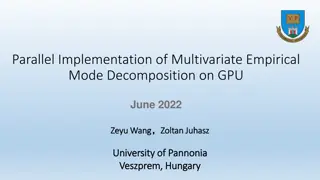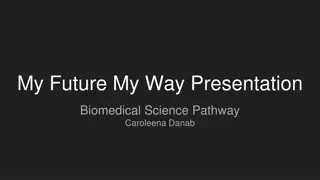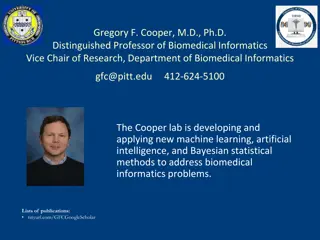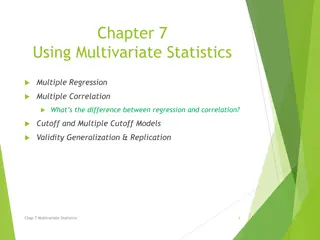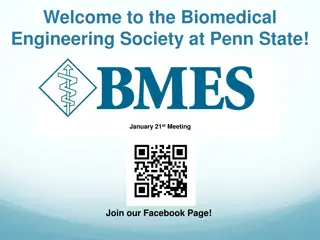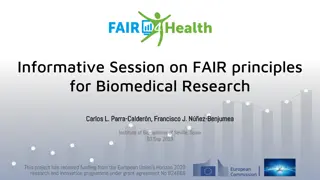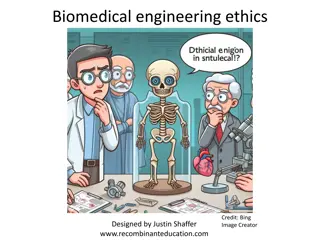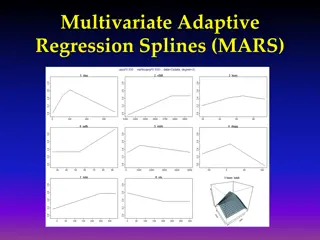Preliminary Report on a Web Platform for Multivariate Biomedical Time-Series Analysis
This preliminary report discusses the development of an innovative web platform for the multivariate analysis of heterogeneous biomedical time-series data. The platform aims to support the detection, classification, and prediction of health disorders by leveraging machine learning algorithms and visualization techniques on various biomedical signals. The focus is on reducing healthcare costs and improving access to quality healthcare through automated disorder classification based on signal analysis.
Download Presentation

Please find below an Image/Link to download the presentation.
The content on the website is provided AS IS for your information and personal use only. It may not be sold, licensed, or shared on other websites without obtaining consent from the author.If you encounter any issues during the download, it is possible that the publisher has removed the file from their server.
You are allowed to download the files provided on this website for personal or commercial use, subject to the condition that they are used lawfully. All files are the property of their respective owners.
The content on the website is provided AS IS for your information and personal use only. It may not be sold, licensed, or shared on other websites without obtaining consent from the author.
E N D
Presentation Transcript
A WEB PLATFORM FOR ANALYSIS OF MULTIVARIATE HETEROGENEOUS BIOMEDICAL TIME-SERIES - A PRELIMINARY REPORT Alan Jovic, Davor Kukolja, Kresimir Jozic, Marko Horvat E-mail: alan.jovic@fer.hr University of Zagreb, Faculty of Electrical Engineering and Computing Department of Electronics, Microelectronics, Computer and Intelligent Systems
CONTENT Motivation Methodology Scenarios for Platform Use Data input Preprocessing, visualization and feature extraction D. Machine learning algorithms and reporting Platform architecture Conclusion Current progress A. B. C. E. 2
MOTIVATION In recent years, the field of web-based telemedicine, has been rapidly evolving: The need to reduce the cost of healthcare expenditure in developed countries To facilitate access to a better healthcare 1) 2) A step further in medicine would be the development of a system for automatic classification of human body disorders based on the analysis of biomedical signals: Recommendations to medical specialists in diagnostics and early detection of various diseases 3
GOAL Construction of innovative web platform that would support multivariate analysis of heterogeneous biomedical time-series (BTS): Web browser data input The analysis of a large number of different BTS and their individual, domain specific features Visualization of signal and disorder Detection, classification, or prediction of various health disorders based on machine learning algorithms 4 Reporting
SCENARIOS FOR PLATFORM USE The analysis process is divided into 8 steps: Analysis type selection Scenario selection Input data selection Records inspection Records preprocessing Feature extraction Model construction Reporting 1. 2. 3. 4. 5. Analysis type selection 6. 7. 8. 5 Scenario selection
SCENARIOS FOR PLATFORM USE An example flow-based diagram of analysis scenario: Model construction for detection of congestive heart failure (CHF) based on heart rate variability (HRV) from 5-minute segments 6
DATA INPUT The platform will enable multiple heterogeneous BTS analysis: ECG, HRV, EEG, EMG, Support for input data records containing a variable number of data arrays We have considered a number of formats, and in the end, we opted to support: European data format (EDF/EDF+) Textual formats for signals and annotations (ANN, TXT, CSV) Image formats JPEG and TIFF. 1. 2. 7 3.
PREPROCESSING ANDVISUALIZATION 2D visualization of the uploaded records: Segments selection, temporal and amplitude scaling, lead(s) selection, header information inspection, Preprocessing: Baseline correction, noise and other filtering, detection of characteristic waveforms, Data transformations: Time domain (e.g. PCA), frequency domain (e.g. FFT), time-frequency domain (e.g. WT) transformations 3D visualization of patient disorders or feature extraction depending on the desired analysis goal 8
FEATURE EXTRACTION For BTS feature extraction, we plan to implement: Domain-specific features (e.g. RMSSD for HRV) General time-series features (e.g. approximate entropy, correlation dimension, etc.) The algorithms from: HRVFrame, EEGFrame Comp-Engine [Fulcher 2013] Additional domain specific feature extraction frameworks Feature extraction will be parallelized Optimally utilization of the available system resources 9
MACHINELEARNINGALGORITHMSAND REPORTING Dimensionality reduction: Removing irrelevant and redundant features Expert system recommendation Typical filters and wrappers feature selection methods Machine learning algorithms For detection and classification models, tree-based and SVM-based algorithms will be provided It will be possible to evaluate the data using standard evaluation procedures (i.e. holdout, cross-validation), both patient-wise (personalized) or regardless of the patient For reporting purposes Java-based JasperReports Library will be used: Web form report, with the possibility to export to PDF, Excel, OpenOffice, and Word documents. 10
PLATFORMARCHITECTURE The analysis platform will be created as a web application: End user base will be larger Application development and maintenance will be less demanding Java was selected for server side mainly because of a large base of existing libraries for signal processing, data parsing, machine learning, and parallelization. On the client side, HTML5, Typescript, and CSS3 will be used for the design of web pages. Client-side platform (frontend) will be developed using Angular 2 framework. 11
CONCLUSION A thorough examination of contemporary technologies for construction of a web platform in the field of multivariate BTS analysis was performed The presented platform will feature a complete process of BTS data records analysis and visualization, with special attention devoted: Efficiency System upgradeability Ease-of-use Application development and maintenance 12
CURRENT PROGRESS Database architecture is defined h2 DBMS is used Data input and signal processing framework is under development The algorithms from HRVFrame and EEGFrame are refactored and verified Test version of backend and frontend is developed to test secure authentication 13
